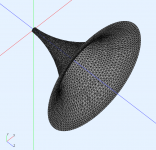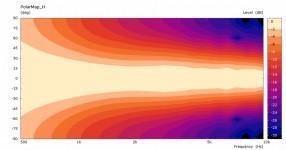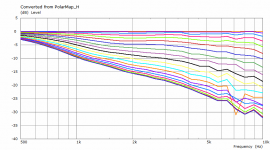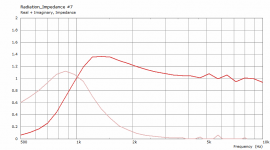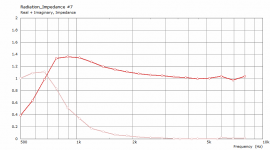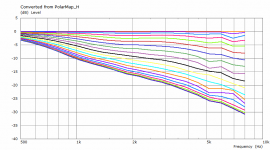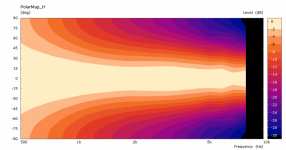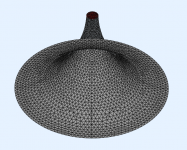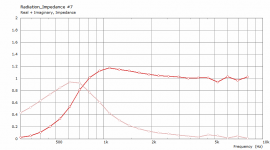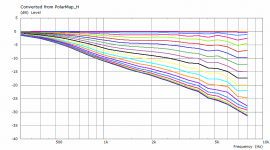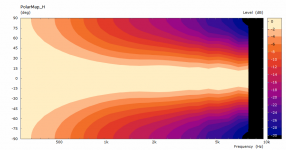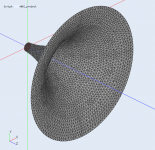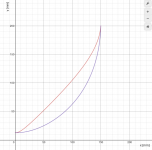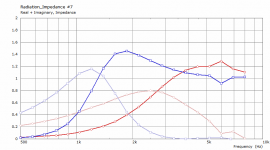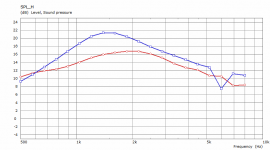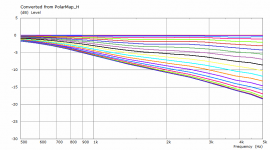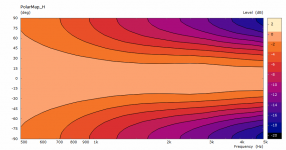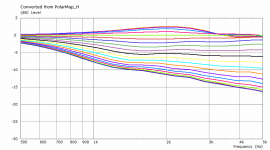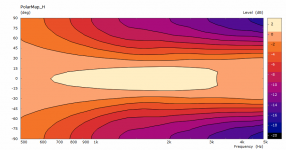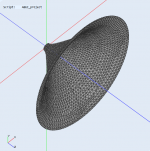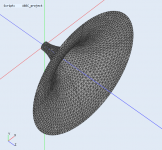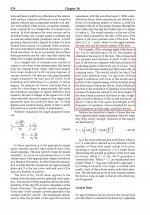That quote is from Sound System..4th ed.
What p. or chapter, so I can find it in a different edition?
Like Marcel, I have been interested in this but seen little analysis, it would be nice to sort it out.
Best wishes
David
Last edited:
It is really not a type of horn as this was also genereted with the same waveguide formula (⌀447 x 290 mm). The possibilites are just enormous, considering that the profile can even change arbitrarily around the horn. There's hardly any classification possible......ATH4 does not belong to that category.
Attachments
Last edited:
Thank you, these are the pieces that help to clarify my understanding. So are there any horns at all that do have a cutoff in the proper sense? You said the lowest mode never goes imaginary, which sounds like there is always some transmission in any horn. So is it that in some horns this is just in a form of a more sudden drop?
The term "cutoff" came from the exponential solution of Webster's Equation. For an infinite exponential horn the solution does go imaginary below a certain point. But there are two issues here: 1) Webster's Equation has been shown to be invalid and; 2) When one solves for a finite exponential horn then once again there is no imaginary range of frequencies in the solution. All frequencies propagate.
Hence, in reality there is no device for which a true "cutoff" exists. For the exponential, the largest drop (slope) does occur at the theoretical "infinite horn cutoff", but this is not necessarily the case for exact solutions.
the red one if horizontal axis, looks almost straight but between the end of throat expansion and he beigining of straight extent -angle-. Looks like an Urushi TDA horn with its internal side flat side, horizontaly flare of TDH horn ?? Sorry at least in a bi-radial scenario ?!
My understanding is the red measure better, am I wrong ?
Sorry for te disgress...
My understanding is the red measure better, am I wrong ?
Sorry for te disgress...
The red one is OS with a slight mouth flare, the blue one is just a random shape, close to a superelliptical arc. Since this was meant mainly for low frequencies, the coarse simulation really holds up to about 5 kHz...
The red one (OS):
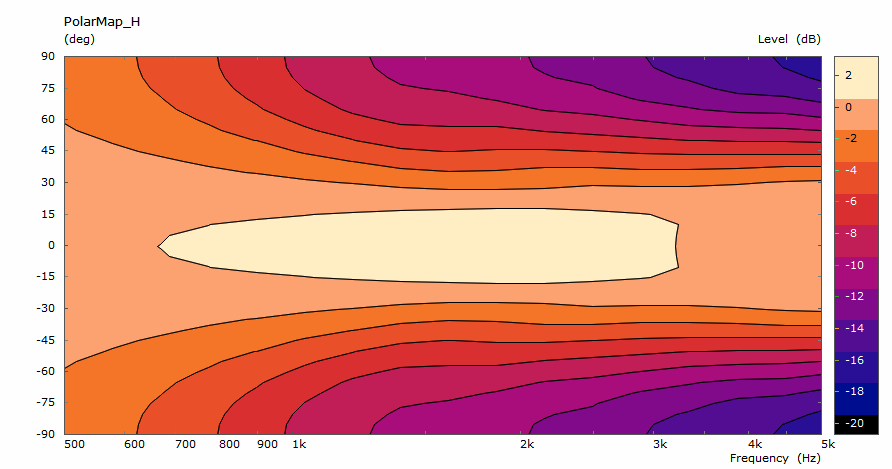
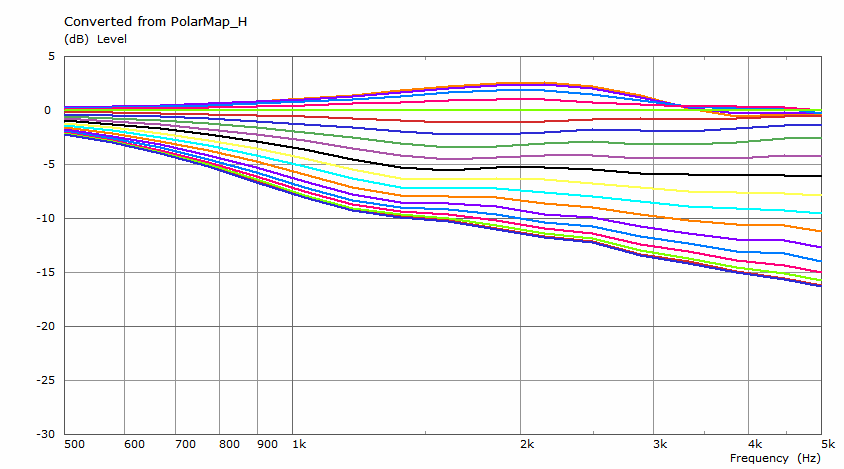
The blue one (elliptical arc):
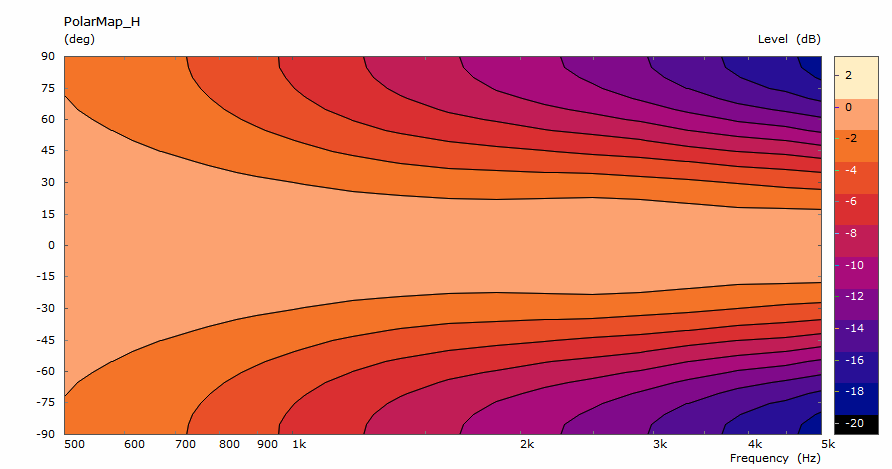
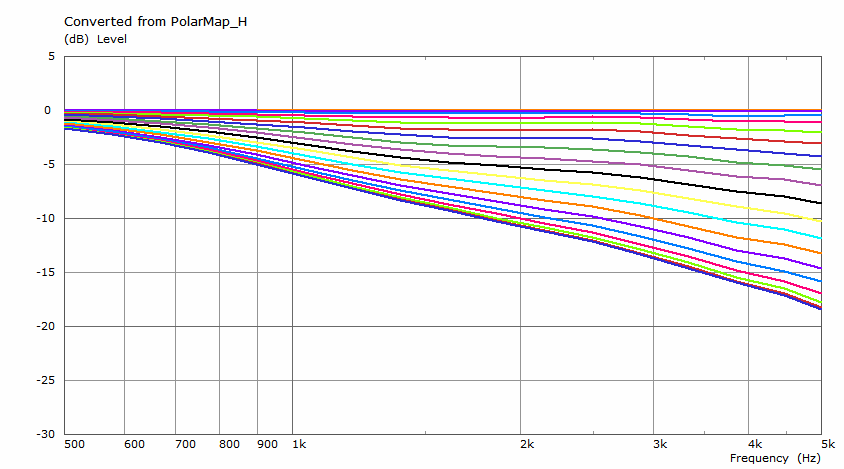
The red one (OS):
The blue one (elliptical arc):
Attachments
What p. or chapter, so I can find it in a different edition?
Like Marcel, I have been interested in this but seen little analysis, it would be nice to sort it out.
Best wishes
David
Attached.
Here's the complete book.
Attachments
The red one is OS with a slight mouth flare, the blue one is just a random shape, close to a superelliptical arc. Since this was meant mainly for low frequencies, the coarse simulation really holds up to about 5 kHz...
Remarkable set of pictures, congratulations!
It is really not a type of horn as this was also genereted with the same waveguide formula (⌀447 x 290 mm). The possibilites are just enormous, considering that the profile can even change arbitrarily around the horn. There's hardly any classification possible...
So, ̶A̶t̶h̶4̶ ...
should actually be: Atw4

Attached.
I already have the book but thank you for the consideration.
However, the quote I wanted to find was this one.
"In the far field, when kr≫1, the first term is dominant and the second term tends to zero as the wave-front rate of expansion tends to zero. When kr≪1, the second term is dominant. The transition from the near field to the far field may be characterised by distance at which the hydrodynamic and propagating particle velocity magnitude are equal. For the spherical source this situation occurs at kr=1
At the radiator surface, r=a, this expression indicates the frequency above which the radiation efficiency is maximal and the majority of source volume velocity results in propagated pressure, and the minority, hydrodynamic pressure. In the context of a horn, the frequency corresponding to this condition is called the cut-on frequency, fc.
For the case of a conical horn
fc=c0/2πa
However, with the conical horn the transition from hydrodynamic to propagation is very gentle.
The acoustical horn functions by controlling the wave front expansion in order to reduce the hydrodynamic pressure compared to the propagating pressure, thus allowing more energy to be radiated for a given volume velocity. The behaviour of horns for loudspeakers is very nicely covered by Holland in [30, p.30]."
Best wishes
David
The red one is OS [ish]...the blue one is...close to a superelliptical arc...
Chapeau, that is very educational.
The polars in post #2213 are not what I would expect from the impedance data and intuition, could they have been swapped?
If this is not a simple slip then my take is that the superelliptical loads better and is not worse in the polars, except perhaps over 5 kHz where we don't have reliable information.
Perhaps that's just confirmation bias because I have used such deeper horns in the past and had planned to build another.
Your view?
Best wishes
David
Last edited:
- Home
- Loudspeakers
- Multi-Way
- Acoustic Horn Design – The Easy Way (Ath4)
